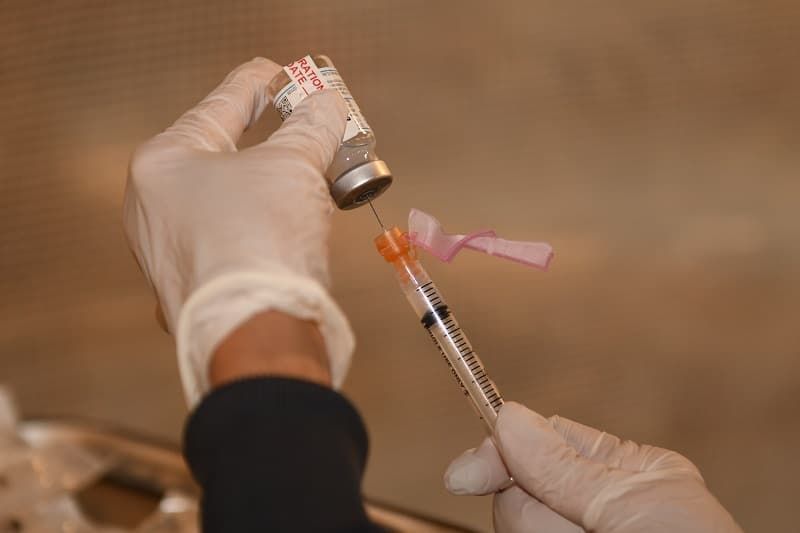On Monday, August 23, the Federal Drug and Food Administration (FDA) gave full approval to the Pfizer-BioNTech COVID-19 vaccine. The vaccine now carries the FDA’s strongest endorsement.
Receiving the agency’s stamp of approval, the vaccine joined the list of FDA-approved vaccines and medications. The vaccine also received a new name—Comirnaty.
Comirnaty will be marketed to prevent COVID-19 in individuals 16 years old and older. For those who are 12 years through 15 years old, and for certain individuals with weakened immune systems (immunocompromised) who are qualified for a third dose, the vaccine remains available under emergency use authorization (EUA).
And as the number of patients with COVID, hospitalizations, and deaths spike throughout the U.S., the FDA’s final green light is what many said they were waiting for before getting vaccinated.
What does full approval mean for the Pfizer vaccine?
“Full FDA approval proves that the most rigorous agency in the world that evaluates new drugs and vaccines has completed this intense process, and that the vaccine is both safe and effective,” says Dr. Jeffrey Weinstein, patient safety officer at Kettering Health.
A vaccine that receives approval at the end of the FDA’s process has the agency’s full confidence. This process includes pre-clinical and clinical stages to determine both a vaccine’s benefits and risks (known or potential).
In other words, full approval is the FDA’s shorthand that a vaccine is verified as safe and effective.
How does a vaccine become FDA-approved?
The FDA has defined a path that a vaccine must take to become FDA-approved.
First, the company that developed the vaccine submits an application (called a Biologics Licensure Application, or BLA) to the FDA. Pfizer submitted theirs in May 2021, followed by Moderna in June.
FDA reviewers then gather the available data about the condition or illness the vaccine is intended to treat. For COVID-19, scientists knew its inner workings by January 2020. By December 2020, when the FDA approved the emergency use of Pfizer’s vaccine, the FDA’s reviewers had mountains of information from scientists and disease experts from around the globe.
A vaccine then goes through three phases to evaluate its safety, effectiveness, and side effects.
- The first phase focuses on the vaccine’s safety and ability to improve the immune system’s response in a small segment of people.
- The second phase involves a wider segment of people to discern the right dosage.
- The third phase involves thousands of people. Close monitoring continues after the third phase.
- The FDA also inspects manufacturing facilities throughout the phases.
Approval of the Pfizer vaccine followed the third phase, which involved 44,000 people and showed the vaccine was 91 percent effective in preventing disease from COVID-19.
The FDA also incorporated its analysis of the vaccine that led to its EUA, along with data collected from 200 million administered doses.
A thorough process in record time
That amount of data became a major factor to the approval process occurring in record time. For some, that has affirmed how large agencies can harness their resources to meet urgent public-health needs. For others, it’s cause for concern.
Because of the data the FDA had available and the escalating risks posed by the delta variant, Pfizer’s vaccine received a “fast track” designation. The FDA reserves the fast-track process for a vaccine showing effectiveness and safety when no alternatives are available, or, for one showing greater effectiveness and safety than available alternatives.
Dr. Weinstein affirms that the FDA “did not rush this approval and fully reviewed all of the scientific data regarding efficacy, safety, and side effects.”
Recently, headlines have gathered around people taking ivermectin (deworming medication for horses) or hydroxychloroquine (FDA-approved to treat malaria) to prevent COVID-19. The FDA has issued statements warning against using either to treat COVID-19.
[Note: Kettering Health is seeing many patients who have tried to prevent or treat COVID-19 with these medications and are admitted for severe and life-threatening COVID-19 infection.]
What’s the difference between full approval and an EUA?
In Dec. 2020, the FDA approved temporary emergency use of Pfizer’s vaccine (a separate approval process) to combat COVID-19.
Along with other terms and phrases appearing on the nightly news, EUA felt foreign, if not confusing.
And while EUAs are rare, they’re nothing new. Nor does the FDA haphazardly issue one.
Before the FDA can issue an EUA, the Department of Health and Human Services (HHS) must declare a public health emergency. And even when that occurs, a vaccine must meet many requirements before the FDA authorizes emergency use.
Since 2004, the FDA has issued EUAs for public health emergencies due to anthrax, Ebola, H1N1, and Middle East respiratory syndrome (MERS).
What does this mean for public health today—and tomorrow?
The FDA’s approval of the Pfizer vaccine is a “key achievement for public health.”
And the milestone arrived not a moment too soon.
The same day the FDA announced the approval, more than 200,000 new cases of COVID were reported in US. And most of the cases throughout the country continue to be among those who are unvaccinated, including in Ohio.
“Our region and the state continue to see significant increases in cases and hospitalizations. Deaths have also been increasing,” says Dr. Weinstein. “While we are seeing some more hospitalizations in people who were previously vaccinated, the large majority of hospitalizations and almost all deaths are among individuals who have not been vaccinated.”
The news, then, of the FDA’s approval brings medical leaders, healthcare workers, and some of those hesitant to get vaccinated a bit of optimism.
This shot of optimism will do some good throughout hospitals’ hallways and inundated ICUs.
But optimism won’t stop a pandemic; improved public health will. And the path toward improving public health—and returning to normal—now has the FDA’s full approval.










